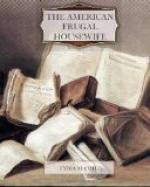Six quarts of meal will make two good sized loaves of Brown Bread. Some like to have it half Indian meal and half rye meal; others prefer it one third Indian, and two thirds rye. Many mix their brown bread over night; but there is no need of it; and it is more likely to sour, particularly in summer. If you do mix it the night before you bake it, you must not put in more than half the yeast I am about to mention, unless the weather is intensely cold. The meal should be sifted separately. Put the Indian in your bread-pan, sprinkle a little salt among it, and wet it thoroughly with scalding water. Stir it up while you are scalding it. Be sure and have hot water enough; for Indian absorbs a great deal of water. When it is cool, pour in your rye; add two gills of lively yeast, and mix it with water as stiff as you can knead it. Let it stand an hour and a half, in a cool place in summer, on the hearth in winter. It should be put into a very hot oven, and baked three or four hours. It is all the better for remaining in the oven over night.
Flour Bread should have a sponge set the night before. The sponge should be soft enough to pour; mixed with water, warm or cold, according to the temperature of the weather. One gill of lively yeast is enough to put into sponge for two loaves. I should judge about three pints of sponge would be right for two loaves. The warmth of the place in which the sponge is set, should be determined by the coldness of the weather. If your sponge looks frothy in the morning, it is a sign your bread will be good; if it does not rise, stir in a little more emptings; if it rises too much, taste of it, to see if it has any acid taste; if so, put in a tea-spoonful of pearlash when you mould in your flour; be sure the pearlash is well dissolved in water; if there are little lumps, your bread will be full of bitter spots. About an hour before your oven is ready, stir in flour into your sponge till it is stiff enough to lay on a well floured board or table. Knead it up pretty stiff, and put it into well greased pans, and let it stand in a cool or warm place, according to the weather. If the oven is ready, put them in fifteen or twenty minutes after the dough begins to rise up and crack; if the oven is not ready, move the pans to a cooler spot, to prevent the dough from becoming sour by too much rising. Common sized loaves will bake in three quarters of an hour. If they slip easily in the pans, it is a sign they are done. Some people do not set a soft sponge for flour bread; they knead it up all ready to put in the pans the night before, and leave it to rise. White bread and pies should not be set in the oven until the brown bread and beans have been in half an hour. If the oven be too hot, it will bind the crust so suddenly that the bread cannot rise; if it be too cold, the bread will fall. Flour bread should not be too stiff.
Some people like one third Indian in their flour. Others like one third rye; and some think the nicest of all bread is one third Indian, one third rye, and one third flour, made according to the directions for flour bread. When Indian is used, it should be salted, and scalded, before the other meal is put in. A mixture of other grains is economical when flour is high.




